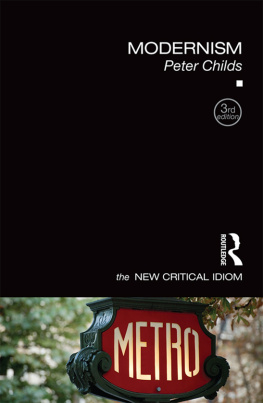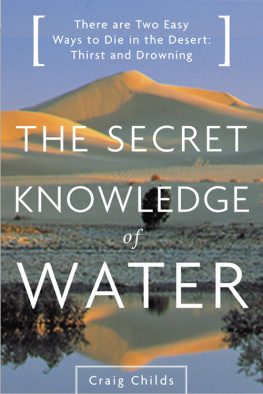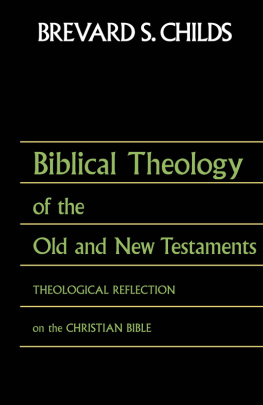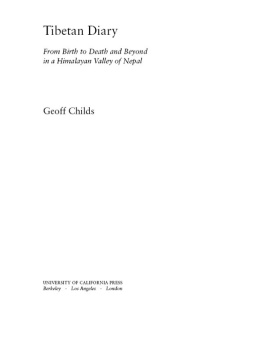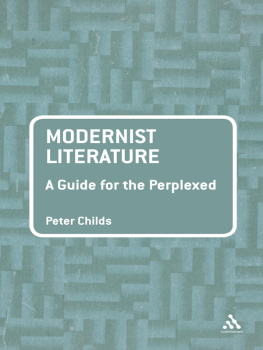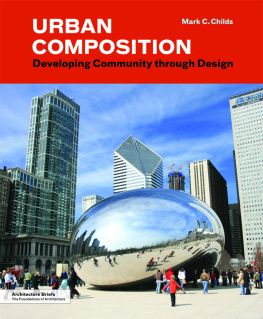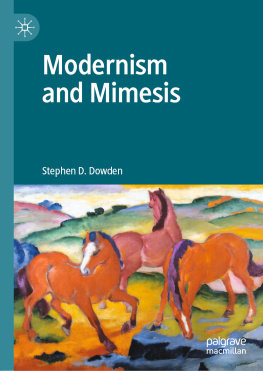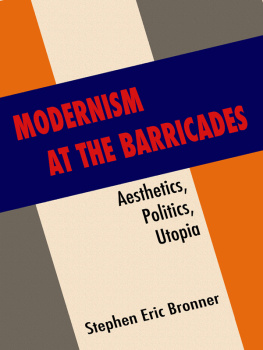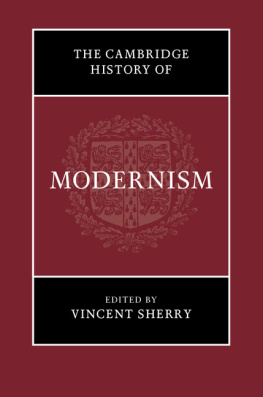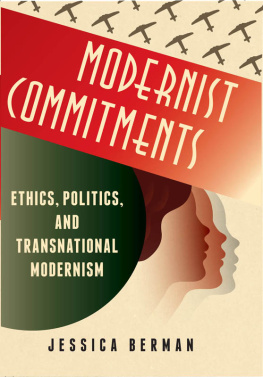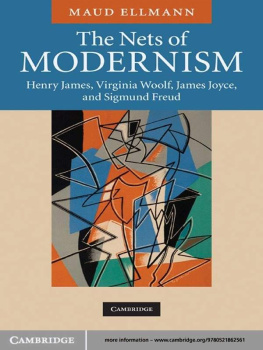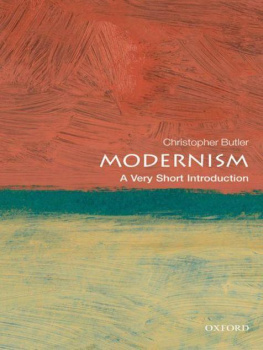Contents

MODERNISM
Modernist movements radically transformed the late nineteenth- and early twentieth-century literary establishment, and their effects are still felt today. Modernism introduces and analyses what amounted to nothing less than a literary and cultural revolution.
In this fully updated, expanded and revised third edition, charting modernism in its global and local contexts, Peter Childs:
details the origins of modernism and the influence of thinkers such as Darwin, Marx, Freud, Nietzsche, Saussure and Einstein;
explores the radical changes which occurred in the arts, literature, drama, and film of the period;
traces modernism at work in literature by a range of authors including James Joyce, Virginia Woolf, Samuel Beckett, Nella Larsen, Gertrude Stein, Katherine Mansfield, T. S. Eliot, and many others;
explains recent critical interest in the culture and worldwide impact of modernism;
reflects upon the shift from modernism to postmodernism.
At once accessible and critically informed, Modernism guides readers from first steps in the field to an advanced understanding of one of the most important cultural phenomena of the last centuries.
Peter Childs is Professor and Pro Vice chancellor at Newman University, UK. He has edited and written over twenty books on diverse subjects ranging from contemporary British culture to post-colonial theory.
THE NEW CRITICAL IDIOM
SERIES EDITOR: JOHN DRAKAKIS, UNIVERSITY OF STIRLING
The New Critical Idiom is an invaluable series of introductory guides to todays critical terminology. Each book:
provides a handy, explanatory guide to the use (and abuse) of the term;
offers an original and distinctive overview by a leading literary and cultural critic;
relates the term to the larger field of cultural representation.
With a strong emphasis on clarity, lively debate and the widest possible breadth of examples, The New Critical Idiom is an indispensable approach to key topics in literary studies.
Also available in this series:
Adaptation and Appropriation second edition by Julie Sanders
Allegory by Jeremy Tambling
The Aphorism and Other Short Forms by Ben Grant
The Author by Andrew Bennett
Autobiography second edition by Linda Anderson
Class by Gary Day
Colonialism/Postcolonialism third edition by Ania Loomba
Comedy second edition by Andrew Stott
Crime Fiction by John Scaggs
Culture/Metaculture by Francis Mulhern
Dialogue by Peter Womack
Difference by Mark Currie
Discourse second edition by Sara Mills
Drama/Theatre/Performance by Simon Shepherd and Mick Wallis
Dramatic Monologue by Glennis Byron
Ecocriticism - second edition by Greg Garrard
Elegy by David Kennedy
Epic by Paul Innes
Fairy Tale by Andrew Teverson
Genders second edition by David Glover and Cora Kaplan
Genre second edition by John Frow
Gothic second edition by Fred Botting
Grotesque by Justin D Edwards and Rune Graulund
The Historical Novel by Jerome de Groot
Historicism second edition by Paul Hamilton
Humanism second edition by Tony Davies
Ideology second edition by David Hawkes
Interdisciplinarity second edition by Joe Moran
Intertextuality second edition by Graham Allen
Irony by Claire Colebrook
Literature by Peter Widdowson
Lyric by Scott Brewster
Magic(al) Realism by Maggie Ann Bowers
Memory by Anne Whitehead
Metaphor by David Punter
Metre, Rhythm and Verse Form by Philip Hobsbaum
Mimesis by Matthew Potolsky
Modernism second edition by Peter Childs
Myth second edition by Laurence Coupe
Narrative second edition by Paul Cobley
Parody by Simon Dentith
Pastoral by Terry Gifford
Performativity by James Loxley
The Postmodern by Simon Malpas
Realism by Pam Morris
Rhetoric by Jennifer Richards
Romance by Barbara Fuchs
Romanticism second edition by Aidan Day
Science Fiction second edition by Adam Roberts
Sexuality second edition by Joseph Bristow
Spatiality by Robert T. Tally Jr
Stylistics by Richard Bradford
Subjectivity by Donald E. Hall
The Sublime by Philip Shaw
Temporalities by Russell West-Pavlov
Translation by Susan Bassnett
Travel Writing by Carl Thompson
The Unconscious by Antony Easthope
MODERNISM
_____________________
Third Edition
Peter Childs

Third edition published 2017
by Routledge
2 Park Square, Milton Park, Abingdon, Oxon, OX14 4RN
and by Routledge
711 Third Avenue, New York, NY 10017
Routledge is an imprint of the Taylor & Francis Group, an informa business
2017 Peter Childs
The right of Peter Childs to be identified as the author of this work has been asserted by him in accordance with sections 77 and 78 of the Copyright, Designs and Patents Act 1988.
All rights reserved. No part of this book may be reprinted or reproduced or utilised in any form or by any electronic, mechanical, or other means, now known or hereafter invented, including photocopying and recording, or in any information storage or retrieval system, without permission in writing from the publishers.
Trademark notice: Product or corporate names may be trademarks or registered trademarks, and are used only for identification and explanation without intent to infringe.
First edition published 2000
Second edition published 2008
British Library Cataloguing in Publication Data
Library of Congress Cataloging-in-Publication Data
Names: Childs, Peter, 1962- author.
Title: Modernism / by Peter Childs.
Description: Third edition. | Abingdon, Oxon ; New York, NY : Routledge, 2016. |
Series: New critical idiom | Includes bibliographical references, glossary, and index.
Identifiers: LCCN 2016014248| ISBN 9781138931619 (hardback : alk. paper) | ISBN 9781138931626 (pbk. : alk. paper) | ISBN 9781315679679 (e-book)
Subjects: LCSH: Modernism (Art) | Arts, Modern19th century. | Arts, Modern20th century.
Classification: LCC NX454.5.M63 C48 2016 | DDC 709.04dc23
LC record available at https://lccn.loc.gov/2016014248
HBK ISBN13: 978-1-138-93161-9
PBK ISBN13: 978-1-138-93162-6
EBK ISBN13: 978-1-315-67967-9
Typeset in Times New Roman PS
by diacriTech, Chennai
C ONTENTS
The New Critical Idiom is a series of introductory books which seeks to extend the lexicon of literary terms, in order to address the radical changes which have taken place in the study of literature during the last decades of the twentieth century. The aim is to provide clear, well-illustrated accounts of the full range of terminology currently in use, and to evolve histories of its changing usage.

